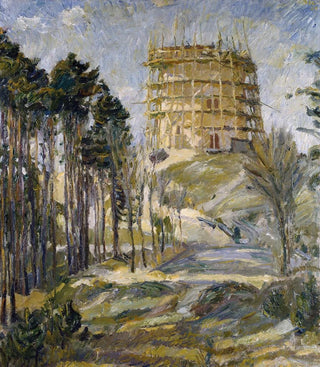Art print | Château d'eau à Hermsdorf - Max Beckmann


View from behind

Frame (optional)
In the vibrant world of modern art, the art print "Château d'eau à Hermsdorf" by Max Beckmann stands out for its boldness and depth. This painting, which captures the essence of a landscape that is both familiar and enigmatic, invites the viewer to fully immerse themselves in a world where reality and imagination coexist. Through dynamic shapes and vibrant colors, Beckmann manages to evoke an atmosphere charged with emotion, while offering a reflection on the human condition. The artist, with his technical mastery and keen sense of composition, takes us on a visual journey where every detail matters.
Style and uniqueness of the art print
Max Beckmann's style is often characterized by an expressionist approach, where intense colors and stylized forms blend to create palpable tension. In "Château d'eau à Hermsdorf," the artist skillfully plays with perspectives and shadows, giving the art print a depth that seems almost three-dimensional. Architectural elements, such as the water tower itself, are rendered with precision that contrasts with the abstraction of the surrounding landscapes. This marriage between figurative and abstract allows Beckmann to transcend the simple landscape and evoke universal themes such as solitude, isolation, and the search for identity. Each brushstroke seems charged with a story, prompting the viewer to question the hidden meaning behind each element of the composition.
The artist and his influence
Max Beckmann, an emblematic figure of 20th-century art, knew how to mark his era with a unique vision and an innovative approach. Born in Germany in 1884, he experienced the tumult of his time, notably World War I, which profoundly influenced his work. Beckmann always sought to express the anxieties and hopes of humanity through his paintings, using a visual language that is uniquely his own. His influence extends beyond his contemporaries, touching generations of artists who saw in him a pioneer of personal expression and visual storytelling. By integrating autobiographical elements

Matte finish

View from behind

Frame (optional)
In the vibrant world of modern art, the art print "Château d'eau à Hermsdorf" by Max Beckmann stands out for its boldness and depth. This painting, which captures the essence of a landscape that is both familiar and enigmatic, invites the viewer to fully immerse themselves in a world where reality and imagination coexist. Through dynamic shapes and vibrant colors, Beckmann manages to evoke an atmosphere charged with emotion, while offering a reflection on the human condition. The artist, with his technical mastery and keen sense of composition, takes us on a visual journey where every detail matters.
Style and uniqueness of the art print
Max Beckmann's style is often characterized by an expressionist approach, where intense colors and stylized forms blend to create palpable tension. In "Château d'eau à Hermsdorf," the artist skillfully plays with perspectives and shadows, giving the art print a depth that seems almost three-dimensional. Architectural elements, such as the water tower itself, are rendered with precision that contrasts with the abstraction of the surrounding landscapes. This marriage between figurative and abstract allows Beckmann to transcend the simple landscape and evoke universal themes such as solitude, isolation, and the search for identity. Each brushstroke seems charged with a story, prompting the viewer to question the hidden meaning behind each element of the composition.
The artist and his influence
Max Beckmann, an emblematic figure of 20th-century art, knew how to mark his era with a unique vision and an innovative approach. Born in Germany in 1884, he experienced the tumult of his time, notably World War I, which profoundly influenced his work. Beckmann always sought to express the anxieties and hopes of humanity through his paintings, using a visual language that is uniquely his own. His influence extends beyond his contemporaries, touching generations of artists who saw in him a pioneer of personal expression and visual storytelling. By integrating autobiographical elements






